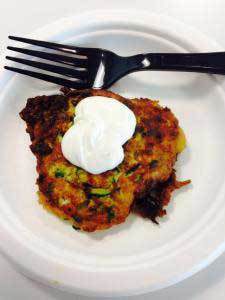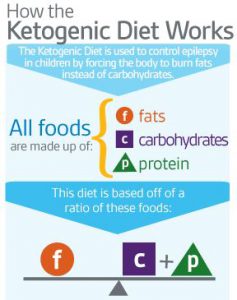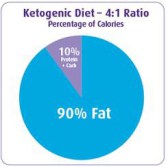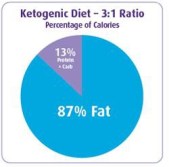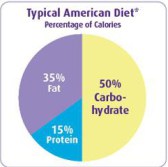How to Create a Ketogenic Birthday Cake That Your Keto Kid Will Love!
 Birthday cakes are so much more than just the ingredients that go into them. They are symbolic of accomplishment, milestones, and the gathering of loved ones to share a treat with the birthday girl or boy. Because of their significance, parents of children on a ketogenic diet may worry that their child will have to miss out on a birthday cake. Thankfully, that is not true!
Birthday cakes are so much more than just the ingredients that go into them. They are symbolic of accomplishment, milestones, and the gathering of loved ones to share a treat with the birthday girl or boy. Because of their significance, parents of children on a ketogenic diet may worry that their child will have to miss out on a birthday cake. Thankfully, that is not true!
Although a typical store-bought birthday cake is simply not an option for a child on the ketogenic diet, rest assured that there are ways to provide a tasty and keto-friendly birthday cake that your child will love. It may take some homework, trial & error, and creativity, so be sure to plan ahead. We’ve collected some ketogenic diet cake recipe ideas that you can choose from. You could use these recipes to make a regular cake or cupcakes. Cupcakes work especially well because you can make a special keto cupcake for the birthday boy or girl and non-keto cupcakes for the rest of the party guests.
Keep in mind that you may need to adjust the recipe to accommodate your child’s ketogenic ratio and calorie requirements, so ask your ketogenic dietitian for help. If the recipe that you want to use is for a 3:1 ketogenic ratio but your child needs a 4:1 ratio, your dietitian may be able to make it work by tweaking the recipe or by adding a side of heavy cream, Liquigen®, or another source of fat to raise the ratio. If you do end up adjusting the ratio, be sure to try out the recipe prior to the big day to make sure it comes out as expected.
Ketogenic Diet Birthday Cake & Frosting Recipes:
- Chocolate Cupcake & Chocolate Cream Frosting: If your little one is a chocolate lover, our KetoCal® Chocolate Cupcake with Chocolate Cream Frosting Recipe is a great option! This recipe is for a 3:1 ratio but as mentioned above, your dietitian may be able to help you make it work by adjusting the recipe or serving it with an additional fat source.
- Chocolate Cupcake: The Matthew’s Friend’s KetoCal Chocolate Muffin recipe can be converted to a cupcake by adding frosting (see frosting recipes ideas below). We have recipes for making it at a 3:1 or 4:1 ratio, along with a Modified Atkins Diet recipe.
- Sprinkle Cake: Keto Cook has this amazing Sprinkle Birthday Cake recipe, a keto-version of the popular “Funfetti” cakes. This recipe is for a 3:1 ratio, but again, your dietitian may be able to help you make it work.
- Buttercream Frosting: The Charlie Foundation and Keto Cook collaborated on this awesome recipe for Buttercream Frosting, which can be used with the Sprinkle cake recipe or whichever recipe you are using. Best of all, they have instructions for making it at a 2:1, 3:1, or 4:1 ratio.
- Whipped Cream Frosting: This recipe for Whipped Cream Frosting is another creation of Keto Cook and the Charlie Foundation. The great thing about this option is that the frosting is a 6.88:1 ratio, so it can be used to bring down the ratio of the cake if needed (ask your dietitian to help you come up with the exact amount required).
Cake Decorations:
Once you have decided on a recipe for the cake and frosting, you can move on to decorating and personalizing it. Party supply stores usually sell cake decorations with kid-friendly themes. You will want to select non-food decoration options (rather than edible decorations made of icing), such as themed baking cups, birthday candles, cupcake picks, figurines, etc. Once you select the theme, you can use keto-friendly food coloring to make matching colored frosting. 
As Dana explained in her recent parent guest blog post on making the ketogenic diet fun for kids, the key is to focus on what your child is interested in at the time. Her daughter wanted a Barbie cake, so Dana used her creative powers to create amazing keto Barbie cupcakes (pictured right). She used miniature Barbie figurines and keto-friendly food coloring to create Barbies with pink and purple cupcake bodices!
Normalcy:
I love that Dana made matching non-keto Barbie cupcakes for the other children so that her daughter didn’t feel like she was eating something different than everyone else. Whenever possible, try to provide your child with keto-versions of the foods that everyone else eats because it helps them to feel normal. If you provide party guests with food (for example, pizza), you could make your child a keto version (for example, our 3:1, 4:1 or MAD keto pizza recipes) so that they feel included in the pizza party. Note- you can make the pizza ahead of time and freeze it so that you just have to warm it on the day of the party.
I am always amazed by the measures that parents take to provide a suitable birthday cake for their child. The moral of the story is that food restrictions don’t have to stop you from giving your little one a happy birthday. When it comes down to it, the cake itself is less important than the effort that goes into making your little one feel special on their day. With a little creativity, everyone can have a great time celebrating another year and milestone.
Thanks for reading Part 1 of my post on ketogenic diet birthday cakes. Next week I’ll post Part 2, which is on making non-food birthday cakes for keto kids who are tube-fed!
–Mallory


 Follow
Follow